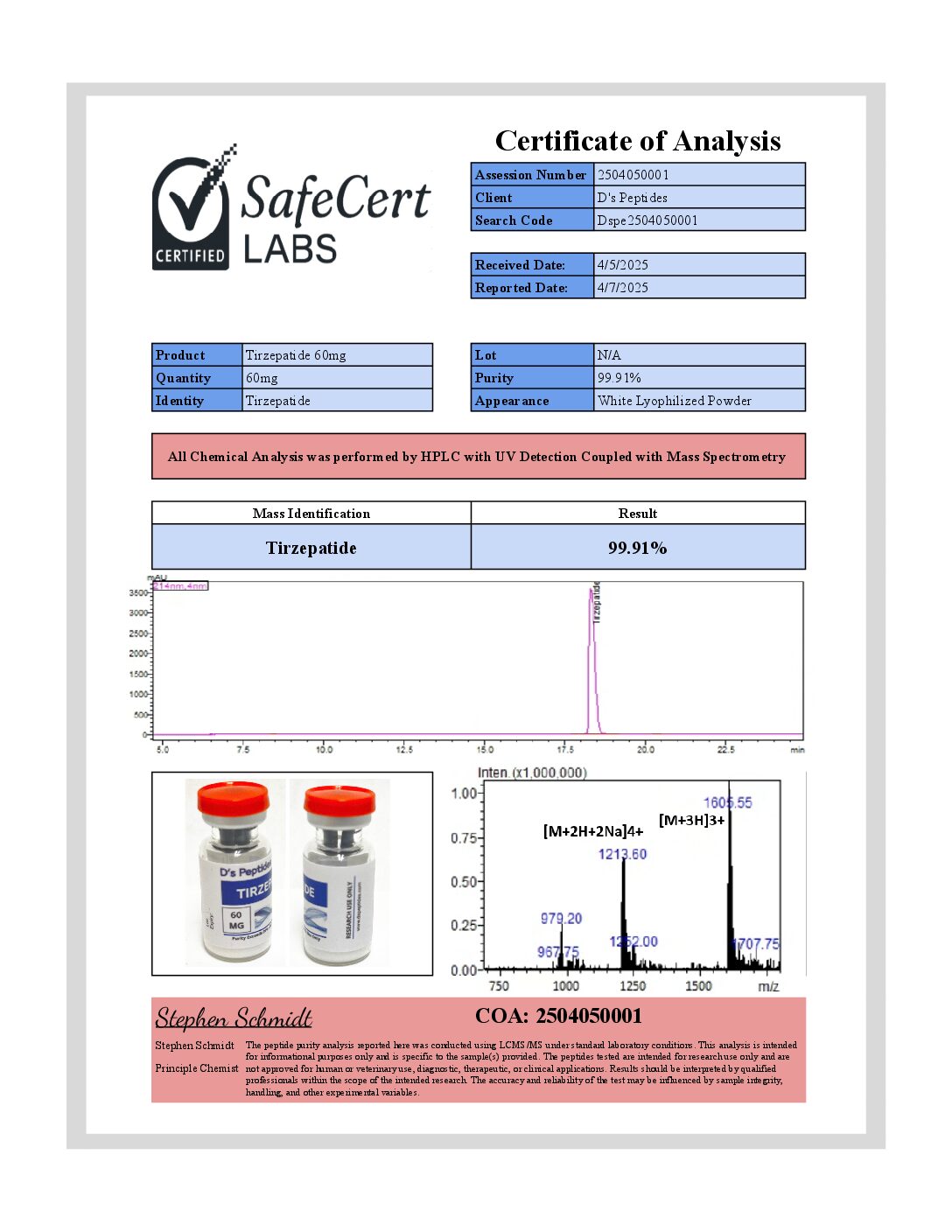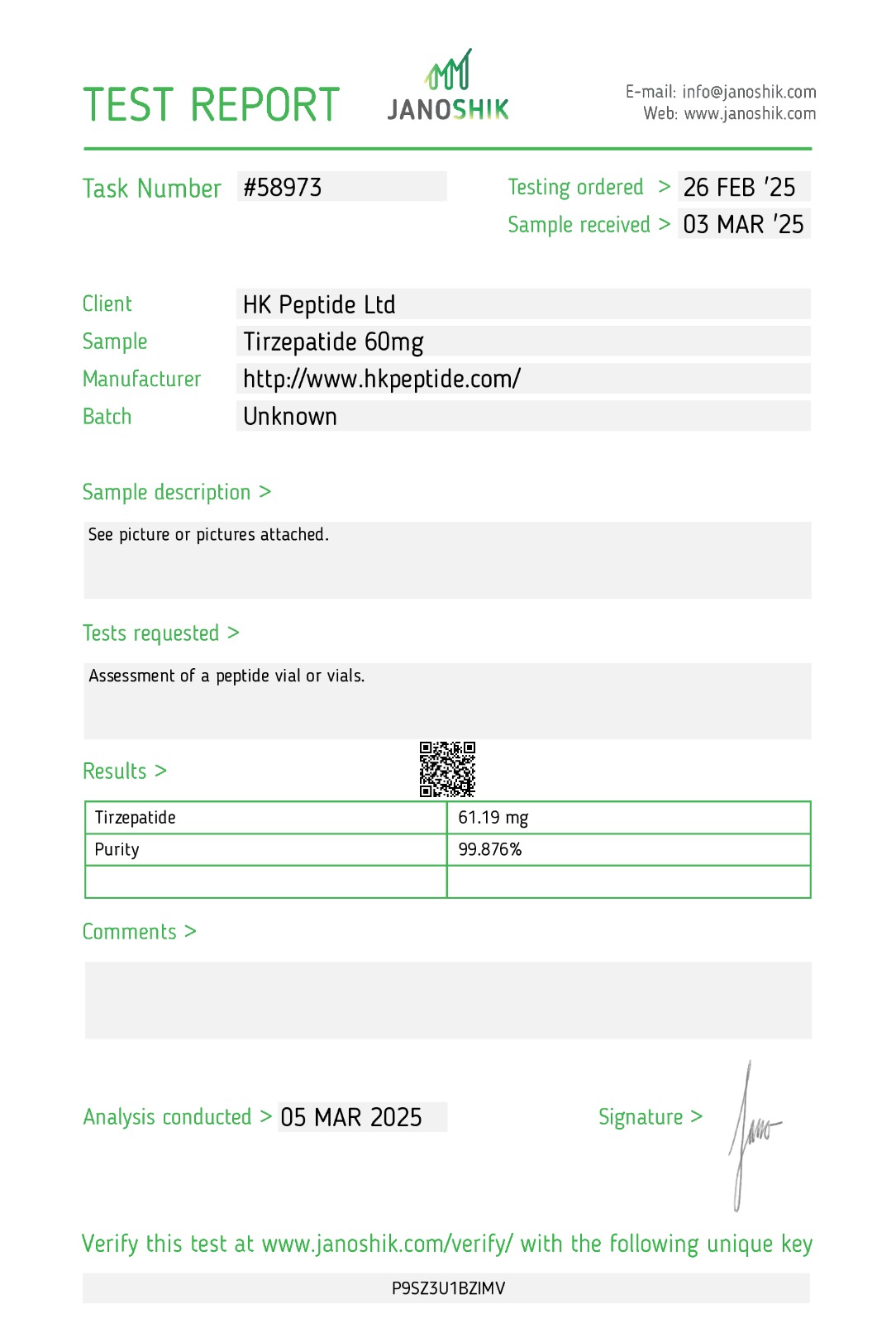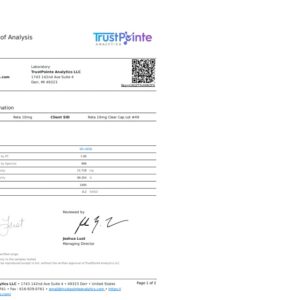All products spoken about or shown are not intended for human consumption in any way. Products listed are offered for use in research only and should not be for human use.
Tirzepatide vial of 60mg
Tirzepatide is a synthetic compound derived from gastric inhibitory polypeptide (GIP) and glucagon-like peptide-1 (GLP-1), known for its ability to Tirzepatide is a synthetic compound derived from gastric inhibitory polypeptide (GIP) and glucagon-like peptide-1 (GLP-1), known for its ability to lower blood glucose levels, enhance insulin sensitivity, and promote weight loss. blood glucose levels, enhance insulin sensitivity, and promote weight loss.
In terms of hunger regulation, Tirzepatide initially delays gastric emptying, leading to increased feelings of satiety and reduced hunger and food cravings. However, this effect diminishes over time due to tachyphylaxis. To address this, a low-dose start with a gradual escalation has been shown to prolong the gastric emptying delay, helping to alter eating patterns over time.
Tirzepatide is also associated with substantial weight loss over six months, which is in contrast to some other GLP-1 analogues that may cause weight gain. The GIP agonism of Tirzepatide appears to play a significant role in its long-term effects on weight. GIP activates receptors in fat cells, increasing insulin sensitivity, reducing adipose inflammation, and increasing adiponectin levels. Additionally, GIP signaling in the central nervous system regulates feeding centers in the hypothalamus, leading to decreased food intake and improved glucose handling, ultimately contributing to weight loss.
Overall, Tirzepatide’s multifaceted actions on insulin release, beta cell function, insulin sensitivity, hunger regulation, and weight loss make it a promising candidate for the treatment of Type 2 diabetes.
Tirzepatide, a synthetic derivative of gastric inhibitory polypeptide (GIP) with simultaneous glucagon-like peptide-1 (GLP-1) functionality, offers a range of potential benefits beyond its primary use in the treatment of Type 2 diabetes. These benefits extend to cardiovascular health and weight management:
Heart Health: Tirzepatide can positively impact heart health by altering adiponectin levels. Increased adiponectin levels are associated with a decreased risk of atherosclerosis, obesity, and heart disease. Tirzepatide has been shown to improve lipoprotein biomarkers, reducing triglyceride levels, apoC-III, and other lipoproteins. This translates to a lower risk of heart disease, possibly through decreased adiposity. Higher adiponectin levels are linked to increased HDL (good cholesterol) and decreased triglycerides, both of which are heart-protective. Additionally, increased adiponectin levels can reduce scavenger receptors in macrophages and promote cholesterol efflux, providing further protection against atherosclerosis.
GLP-1 and Cardiovascular Risk Factors: GLP-1, one of the components of Tirzepatide, plays a vital role in regulating cardiovascular risk factors such as hypertension, dyslipidemia, and obesity. It helps lower blood pressure, improve lipid profiles, and contribute to weight loss. The effect on endothelial function is noteworthy, with GLP-1 signaling leading to blood vessel relaxation, reduced blood pressure, and improved end-organ perfusion. GLP-1 signaling can also reduce inflammation, a key factor in atherosclerosis development.
Inflammation Reduction: Inflammation is a significant contributor to atherosclerosis and cardiovascular disease. GLP-1 signaling has been shown to reduce inflammation through various mechanisms, including decreased NF-κB signaling, reduced MMP-9 activity, inhibition of inflammatory cytokine synthesis, and decreased inflammatory macrophage activity. These anti-inflammatory effects can last for several months after a single dose of a GLP-1R agonist like Tirzepatide.
Clinical Trials for Heart Failure: Tirzepatide is currently undergoing clinical trials to further assess its medium-term effects on individuals with heart failure, indicating its potential as a treatment option for heart-related conditions.
In summary, Tirzepatide, initially developed for the treatment of Type 2 diabetes, demonstrates significant cardiovascular benefits by positively influencing risk factors such as adiponectin levels, blood pressure, lipid profiles, and inflammation. These effects can help reduce the risk of heart disease and improve overall cardiovascular health.
Tirzepatide 20mg is a groundbreaking research peptide designed to assist individuals in their journey towards effective weight loss. Tirz operates through a unique mechanism of action, targeting multiple pathways involved in glucose metabolism and appetite regulation. By mimicking the effects of naturally occurring hormones in the body, Tirz enhances insulin sensitivity, reduces appetite, and promotes a feeling of fullness, making it an invaluable tool for research.
Clinical studies have demonstrated the efficacy of Tirz in significantly reducing body weight in patients with varying degrees of obesity. Participants in these studies reported not only a decrease in weight but also improvements in overall metabolic health, including reductions in blood sugar levels and improvements in lipid profiles.
Tirz represents a significant advancement in the field of weight management. Its unique formulation and proven effectiveness make it a promising option to achieve sustainable weight loss and improve overall health.
Newer research study: https://www.nejm.org/doi/full/10.1056/NEJMoa2107519
What Is Tirz?
Tirzepatide is an research analog peptide to the glucose-dependent insulinotropic polypeptide (GIP). It is a novel peptide, Tirz is a synthetic derivative of gastric inhibitory polypeptide (GIP),Gastric inhibitory peptide (GIP) is a hormone produced by the duodenum and small intestine. It acts as an incretin and stimulates the production of insulin. Unlike GIP, which is made of 42 amino acids, Tirz has a modified amino acid chain consisting of 39 amino acids which are additionally lipidated to improve the peptides uptake into cells and its stability during metabolism.
Tirz as a peptide hormone ,that has the potential to act as an agonist at both the gastric inhibitory polypeptide (GIP) receptor and the glucagon-like peptide-1 (GLP-1) receptor. The action of Tirzepatide (GIP) peptide is apparently mediated through activation of the GLP-1 and GIP receptors, possibly leading to enhanced insulin secretion, glucose uptake, and satiety signaling.
How Tirz Works ?
Tirz is a GIP receptor and GLP-1 receptor agonist. It is a 39-amino-acid modified peptide with a C20 fatty diacid moiety that enables albumin binding and prolongs the half-life. Made up of 39 amino acids, the relatively large Tirzepatide stimulates the release of insulin from the pancreas by binding to both GIP and GLP-1 (glucagon-like peptide-1) receptors. Tirzepatide selectively binds to and activates both the GIP and GLP-1 receptors, the targets for native GIP and GLP-1. The affinity of Tirzepatide for the GIP receptor is greater than its affinity for the GLP-1 receptor.
Product Code: Tirz60
Product Condition: New
weight: 2.0oz







